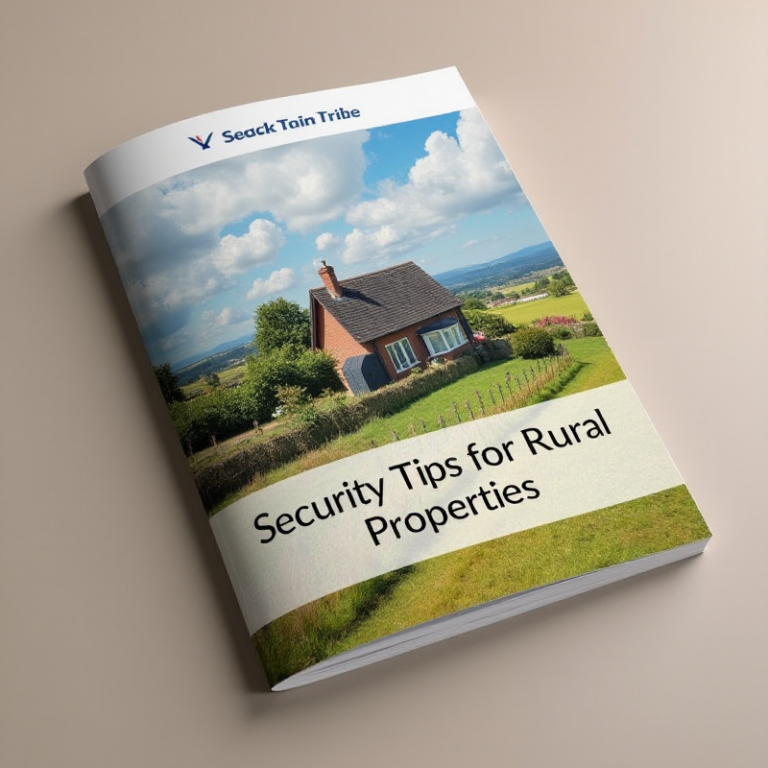Rural properties, with their peaceful surroundings and distance from the hustle of city life, offer unique challenges when it comes to maintaining security. The isolation that provides tranquility can also make these properties more susceptible to theft, vandalism, and other security concerns. Ensuring the safety of a rural home or farm requires a tailored approach that combines traditional and modern methods.
1. Strengthen Perimeter Security
The first line of defense for rural properties starts at the perimeter. Having clear boundaries and reinforced access points helps deter potential intruders.
- Install Sturdy Fences and Gates: A strong, well-maintained fence around the property acts as a visual and physical barrier. Ensure the gates are lockable and in good working condition.
- Use Natural Barriers: Plant thorny bushes such as hawthorn or roses along vulnerable entry points. These can serve as an effective deterrent while blending seamlessly into the landscape.
- Visible Signage: Signs indicating the presence of security cameras, guard dogs, or alarms can dissuade potential trespassers.
2. Illuminate Key Areas
Good lighting is essential to rural security. Darkness is a significant advantage for those looking to approach properties unnoticed.
- Install Motion-Sensor Lights: Place these at entry points such as gates, doors, and driveways. Sudden illumination can startle intruders and alert homeowners to movement.
- LED Floodlights: Consider investing in energy-efficient floodlights for barns, garages, and storage units. Solar-powered options are ideal for properties without ready access to electricity.
- Strategic Light Placement: Ensure that lighting covers hidden areas around the property where intruders might approach.
3. Adopt Advanced Surveillance Solutions
Even in remote areas, modern technology can be a game-changer for property security.
- CCTV Cameras: Wireless cameras with night vision and remote access features are crucial. Install them at various vantage points to cover the perimeter, entrance, and vulnerable spots.
- Trail Cameras: These motion-activated cameras, often used by hunters, can capture images and videos when triggered. They’re discreet and effective for large properties.
- Connected Monitoring Systems: Many smart home systems allow property owners to monitor live feeds and receive alerts on their smartphones if motion is detected.
4. Reinforce Building Security
Securing the main house, barns, sheds, and any outbuildings is as important as protecting the land itself.
- Secure Doors and Windows: Reinforce doors with heavy-duty locks and security bars. Use window locks and shatter-resistant glass where possible.
- Alarm Systems: Consider installing a basic or advanced alarm system. A loud alarm can deter intruders and alert nearby residents.
- Grills and Shutters: Metal grills for windows or security shutters can add an extra layer of protection, especially for buildings left unattended for long periods.
5. Leverage Community and Neighbors
Rural communities often have a strong sense of camaraderie. Neighbors can be a crucial part of a broader security network.
- Build a Network: Maintain good relationships with nearby property owners. Inform them of planned absences so they can keep an eye out for unusual activity.
- Create a Communication System: Use local messaging groups or apps designed for neighborhood watches to share updates and tips about suspicious behavior.
- Schedule Regular Patrols: Coordinate with neighbors to occasionally patrol each other’s properties, especially during vacations or peak crime seasons.
6. Employ Guard Animals
Guard animals, especially dogs, have been a trusted line of defense for centuries.
- Guard Dogs: Breeds such as German Shepherds, Great Pyrenees, and Anatolian Shepherds are excellent for protecting livestock and property.
- Geese and Donkeys: Less commonly thought of, but geese are highly vocal and can act as an alarm. Donkeys are known to protect livestock from predators and can be intimidating to intruders.
7. Implement Access Control
Preventing unauthorized vehicle and foot traffic is essential for maintaining security on a rural property.
- Driveway Alarms: These devices alert you when a vehicle or person approaches your property.
- Gated Entry Systems: Install gates with keypad entry or electronic remote control to prevent unwanted visitors.
- No Trespassing Signs: Legally enforce boundaries with visible no trespassing signs, making it clear that unauthorized entry is prohibited.
8. Emergency Preparedness and Response Plan
Even with the best preventative measures, it’s essential to have a plan in place should a security breach occur.
- Emergency Contacts: Have numbers of local law enforcement and trusted neighbors readily available.
- Secure Valuables: Store expensive tools, machinery, and other valuables in a locked building or a safe.
- Backup Communication Devices: Ensure you have a working phone and, if possible, a secondary communication device like a two-way radio in case of an emergency.
Conclusion
Securing a rural property is about balancing traditional safety measures with modern technology. By reinforcing physical barriers, leveraging smart technology, and engaging the community, property owners can significantly reduce the risk of crime. Vigilance and preparedness are key to ensuring that the peace and privacy of rural living remain uninterrupted.
Similar article: Essential Homestead Safety Measures for Secure Living



